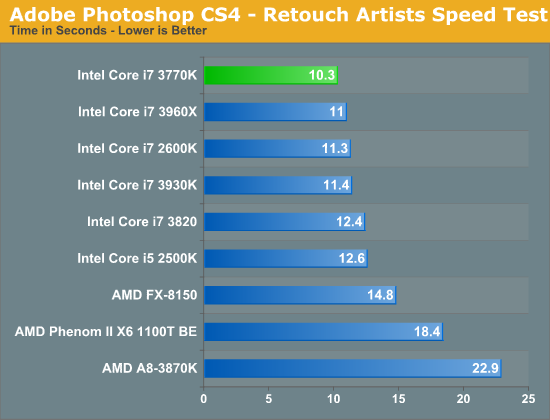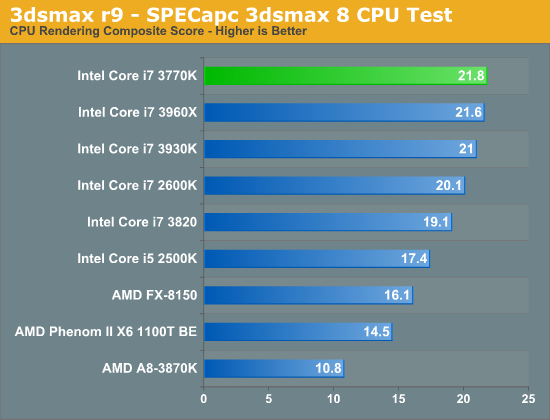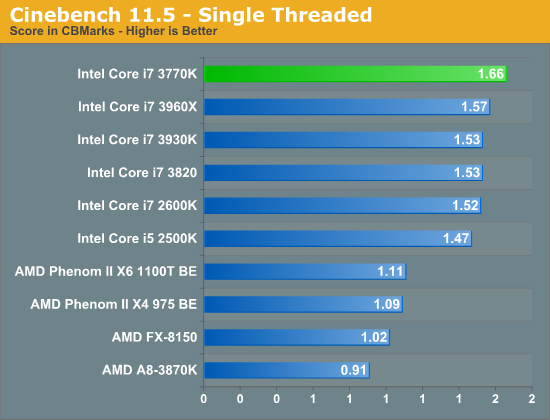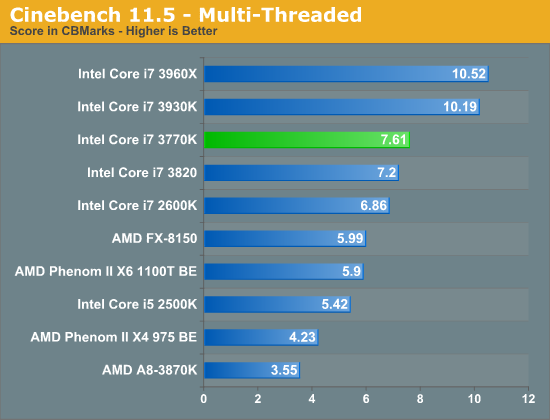The Ivy Bridge Preview: Core i7 3770K Tested
by Anand Lal Shimpi on March 6, 2012 8:16 PM EST- Posted in
- CPUs
- Intel
- Core i7
- Ivy Bridge
Content Creation Performance
Adobe Photoshop CS4
To measure performance under Photoshop CS4 we turn to the Retouch Artists’ Speed Test. The test does basic photo editing; there are a couple of color space conversions, many layer creations, color curve adjustment, image and canvas size adjustment, unsharp mask, and finally a gaussian blur performed on the entire image.
The whole process is timed and thanks to the use of Intel's X25-M SSD as our test bed hard drive, performance is far more predictable than back when we used to test on mechanical disks.
Time is reported in seconds and the lower numbers mean better performance. The test is multithreaded and can hit all four cores in a quad-core machine.

Our Photoshop test is well threaded but it doesn't peg all cores constantly. Instead you get burstier behavior. With the core count advantage out of the way, SNB-E steps aside and allows the 3770K to step up as the fastest CPU we've tested here. The performance advantage over the 2600K is around 9%.
3dsmax 9
Today's desktop processors are more than fast enough to do professional level 3D rendering at home. To look at performance under 3dsmax we ran the SPECapc 3dsmax 8 benchmark (only the CPU rendering tests) under 3dsmax 9 SP1. The results reported are the rendering composite scores.

In another FP heavy workload we see a pretty reasonable gain for Ivy Bridge: 8.5% over a 2600K. This isn't enough to make you want to abandon your Sandy Bridge, but it's a good step forward for a tick.
Cinebench 11.5
Created by the Cinema 4D folks we have Cinebench, a popular 3D rendering benchmark that gives us both single and multi-threaded 3D rendering results.

The single threaded Cinebench test shows a 9% performance advantage for the 3770K over the 2600K. The gap increases slightly to 11% as we look at the multithreaded results:

If you're running a workload that can really stress multiple cores, the 6-core Sandy Bridge E parts will remain unstoppable but in the quad-core world, Ivy Bridge leads the pack.










195 Comments
View All Comments
arno - Friday, March 9, 2012 - link
No, it is just out of question for me to overclock. I wanna buy a profesional laptop (w520 lenovo). SO no way to teak it.Fact is memory will be 1600 Mhz and the processor a bit stronger with maybe a better memory controler.
At one month of the release, it worth to wait it.
Just wanna make sure that in my particular case it really worth it cause i'm tired of my heavy old laptop. I buy this damn machine just for working after all. At home, my E8400 is still upto date for what I do with it.
DDR4 - Friday, March 9, 2012 - link
I want to see some increase in performance and actual processing power. For now, i can leave the graphics to the GPU.Nexing - Friday, March 9, 2012 - link
@ArnoI'd consider a few aspects:
-Do you need to use precision external gear, -like we audio people do with soundcards- and hence need ExpressCard or Thunderbolt connectors? Then I'd expect May-Jun launches will bring those professional Laptops and Ultrabooks.
-If portability is important, factual Sandy bridge battery capacity is near 4 hours whether Ivy Bridge battery will extend real usage around eight hours for similar performance.
-Furthermore USB 3.0 will be native, something important since most renesas boards have been far from perfect and just their recent (Feb/March 2012) releases seem to finally have nailed efficiency.. Problems with USB 3.0 equiped Sandy Bridge laptops abound in forums, and that is in professional brands.
-If you were questioning about SandyB vs IvyB desktops, you could still buy now the former and later upgrade for the later CPU, but with the mobile platform, Intel has stated that H67M -their actual chipsett platform, also named Cougar Point- Upgradeability is not going to be feasible, despíte it could be technically possible easily..
Therefore, there a many reasons pointing to wait. Since sales are very low, any are choosing this route.
arno - Saturday, March 10, 2012 - link
Thanks Nexing for u answer. Actually, i totally agree with you on:portability => IB is a shrink and must be more power efficient for an equivalent task load. Seems that the test proves it. moreover, I will work a lot in trains or outdoors (visiting customers), so it is definitely a +.
USB 3 => u feedback is very interesting. I myself think that "native" versus "add on" USB3 feature must be better. And that was also a reason for me to wait when last december, i was already thinking of buying something new. Now i'm quite sure that it was the good thing to do.
For the rest, more than external gears, I need a processor good in floating points calculation. I do intensive electrical simulations so i definitely need it.
I took my decision and I will wait. This laptop will replace and desktop and laptop for work (and work only cause for internet or usual offices task, i definitely think a core 2 duo can make it); so better to catch the best. I will manage the present emergency I have, praying for Lenovo (or Samsung?) to offer new Ivy Bridge laptop as soon as possible. Let's make a bet: Lenovo got it ready to release and is just waiting for the official launch date....
thanks for sharing ;)
Nexing - Friday, March 9, 2012 - link
Should say:"many are taking this waiting route"
arno - Saturday, March 10, 2012 - link
"FP/integer divider delivers 2x throughput compared to Sandy Bridge"I should read more carefully. That is an answer to my question. Maybe not a spectacular improvement, but still one.
DrWattsOn - Tuesday, March 13, 2012 - link
@arno I'm GLAD you didn't read more carefully, because you posted the question, and Nexing's answer focused me on something I still wasn't considering as a major factor in my decision: USB3. Between your question and the response, I also got a better picture of how specific use is affected by the tech. So, I'm a waiter (tho I don't serve food 8^D ).stephenbrooks - Saturday, March 10, 2012 - link
Intel released on 2006, 2007, 2008, 2010, 2011, 2012.In base 9 they're on schedule.
bhima - Saturday, March 10, 2012 - link
Basically every 2D-based graphic designer/web designer doesn't need a discrete GPU for their work. The IGPs handle that workload fine (mainly because most of the processing needed for photoshop, indesign, illustrator or dreamweaver is CPU based). A discrete GPU gives you better performance with the very limited 3D stuff that photoshop offers which is situational at best for the vast majority of graphic designers.3D artists and those that pump a ton of effects in video editing, they would benefit from discrete.
shadow king - Monday, March 12, 2012 - link
^ =)